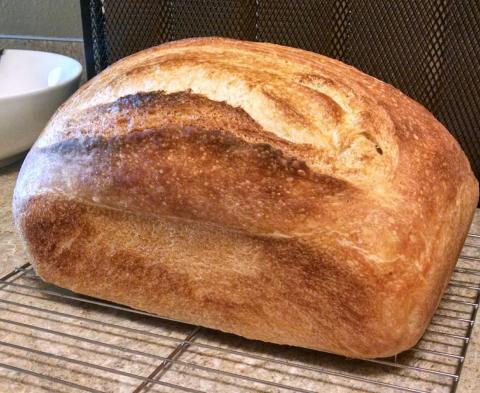
YASSB, take 2: "Yes, Virginia, You Can Overknead by Hand"

Well, after some helpful advice and some more recipe reading for process, plus a little more thinking about what I want out of this recipe, here's take 2. I've evened out the hydration so it stays closer to 80% until the last of the flour goes in, which is about as stiff as I can still work with it and not have to resort to actual kneading until it's time.
The biggest thing for me, though, was unlearning the idea that "you can't overknead bread by hand." While that may be true from a strictly mechanical gluten strength standpoint, in that my hands will never generate enough torque to tighten the gluten web until it breaks, it certainly isn't true from a bread texture standpoint. The question is, how tight a gluten web is tight enough? One can certainly knead dough to a point where it is tougher than desirable for a given crumb texture; light and airy isn't only for breads with big holes.
Dabrownman suggested I have a look at the 1.2.3 recipe, which is nothing like as fiddly as mine in terms of ingredient staging. (It can be dumped in a bread machine for processing, for example.) And yet it reminds me why mine is fiddly: I'm letting the ingredient ratios do the work. Keeping the yeast and bacteria well-fed but under-hydrated to influence acid production. (The missing ingredient is cooler temperatures right now!) But that lower hydration in the preferments also does work in building the dough. That's always what I read about biga as opposed to poolish: stiffer starter provides a head-start on bread strength.
Which means that when I knead this recipe as though I had to build all of the gluten structure myself, I'm really overworking the dough! (Not to mention aggravating my carpal-tunnel syndrome needlessly.) Old bad habits I have to unlearn, trying to get a windowpane-capable mass by main force. So here's the tweaked recipe, now with baker's percentages in the staging:
49 AP flour
40 bread flour
11 whole wheat
67.5 water
4 starter
2 salt
Step 1: activation
32 g starter + 20 g water + 20 g AP + 8 g whole wheat = 82% hydration
(Baker's Math: 4 starter + 2.5 water + 2.5 AP + 1 WW)
Step 2: first feeding (10–12 hours later)
… + 80 g water + 52 g AP + 40 g whole wheat = 85% hydration
(… + 10 water + 6.5 AP + 5 WW)
Step 3: second feeding (10–12 hours later)
… + 160 g water + 160 g AP + 40 g whole wheat = 82% hydration
(… + 20 water + 20 AP + 5 WW)
Step 4: building the dough (4 hours later)
… + 280 g water + 96 g AP + 256 g bread flour = 81% hydration
(… + 35 water + 12 AP + 32 BF)
Step 5: kneading (after 30 mins autolyse)
… + 16 g salt + 64 g AP + 64 g bread flour = 68% hydration
(… + 2 salt + 8 AP + 8 BF)
As to kneading, I had taken to doing degassing with stretch-and-fold in the bowl during bulk fermentation already, in lieu of preshaping after, just to keep the mass comfortably inside the bowl in this warm weather. So instead of my old bad-habit kneading, I got all the necessary flour into the mass in one 5-minute session of stretching and folding on the silpat, rested it again to hydrate that flour, and then shaped it for the bowl immediately. No fussing about too-sticky dough, just letting it be what it is. If I want higher hydration, all I have to do is add less flour—though that'll screw up the math.

The results were worth it! An inch more oven spring than my last loaf. (Frankly, it looks like a boule that I managed to wedge into a loaf pan somehow.) And the mie is much softer and lighter in texture, for the same relative gas bubble volume.



Comments
And doing a great job of applying the lessons you have learned. Good work, eleutheros!
Paul
So, are you saying that instead of kneading you are just doing stretch and folds?
I don't know how this is going to work with the cheddar and thyme batard I plan to make tomorrow, because I want to avoid cooked-cheese lumps, but yeah, kind of. And yet not exactly.
It's not the same as stretch-and-fold with an already kneaded mass; it started out more like a taffy pull. Much more stretching, while the ragged dough would allow it, exposing much more surface and incorporating the last of the flour much faster. For me, it was a shift to pulling and folding instead of pushing and folding. Once everything was in, it quickly stopped being ragged, a good tension began to develop, and it would hold a shape, so I stopped working it and put it in the bowl. From there, it was stretch-and-fold in the bowl for four hours of bulk fermentation.
In my brain/for my hands and what they're used to, this is nothing like kneading. So much of the work is already done in the mixing, from the fact that the whole process is done at a stiffer consistency. I may have to go in for something like Forkish does, with wet hands and squishing, if I want less development in the mixing.
(Or I could just accept that I've made myself a relatively low-knead sandwich-texture sourdough, which has its limits.)
a good one too!